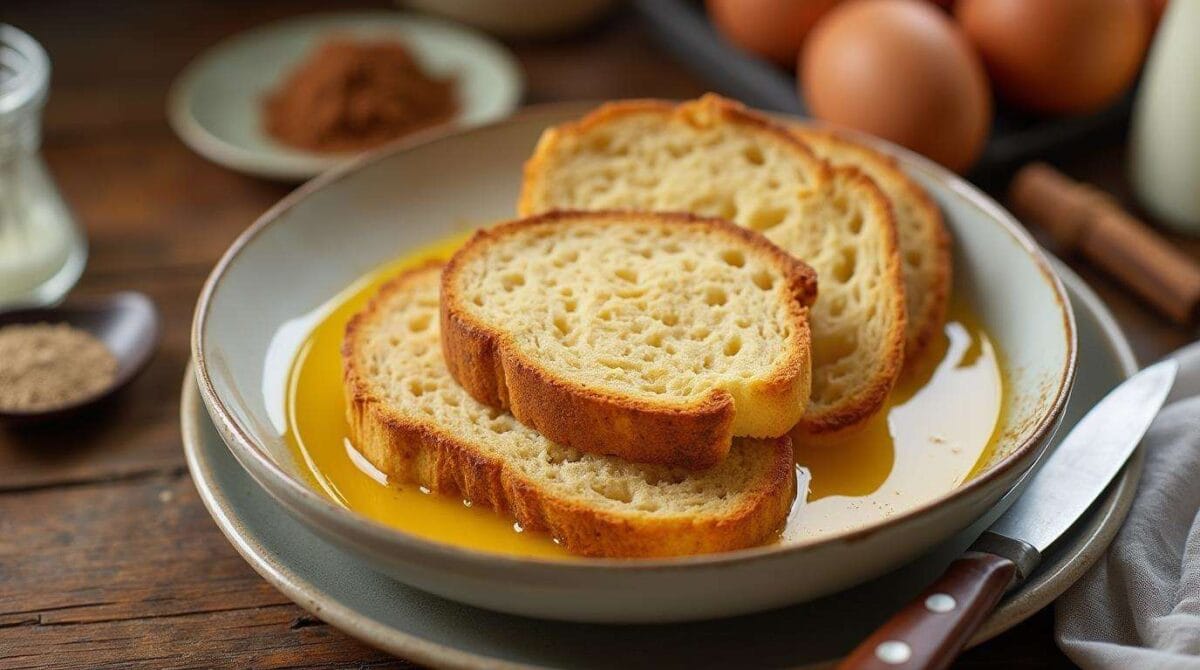There’s nothing quite like sourdough French toast to elevate your breakfast game. Whether you’re craving a hearty meal or looking to impress guests at brunch, this dish is a surefire winner. Combining the tangy depth of sourdough bread with a rich, cinnamon-infused custard, it’s a match made in culinary heaven. In this guide, we’ll explore everything you need to know—from the perfect ingredients to tips, techniques, and creative twists.
Let’s dive into the art of crafting the ultimate sourdough French toast, one delicious bite at a time!
Table of contents
What is Sourdough French Toast?
Sourdough French toast is a classic twist on traditional French toast, using the unique tang and texture of sourdough bread. Unlike regular bread, sourdough has a robust structure and a slightly chewy crumb, making it perfect for soaking up the creamy custard without falling apart. Its slight tang adds depth, creating a flavor profile that’s richer and more satisfying than the norm.
But French toast isn’t just a dish; it’s an experience. It’s the kind of breakfast that feels indulgent yet simple—a nostalgic treat that takes you back to warm kitchens and Sunday mornings.
Why Sourdough Bread is Ideal for French Toast
Sourdough bread stands out as the ultimate base for French toast. Why? Here are three compelling reasons:
- Texture: The dense, slightly chewy crumb of sourdough bread holds up beautifully to soaking, ensuring each slice is tender but not mushy.
- Flavor: Its tangy notes balance the sweetness of the custard and toppings, offering a more complex taste.
- Durability: Day-old sourdough slices have the perfect firmness, making them less prone to breaking during preparation.
A Brief History of French Toast and Its Evolution
Did you know that French toast isn’t actually French? Versions of this dish date back to ancient Rome, where stale bread was soaked in a milk-and-egg mixture, then fried. Known as pain perdu in France (literally “lost bread”), the dish was a way to transform leftovers into a decadent meal.
Fast forward to today, and French toast has become a beloved breakfast staple worldwide, with sourdough emerging as a modern favorite. The rustic charm of sourdough combined with its versatility makes it a top choice for reinventing this timeless dish.
Ingredients for Sourdough French Toast

Essential Ingredients You’ll Need
Crafting the perfect sourdough French toast starts with high-quality ingredients. Here’s what you’ll need:
- Sourdough bread: Opt for slices about ¾-inch thick. Day-old or slightly stale sourdough works best since it absorbs the custard beautifully without falling apart.
- Eggs: The foundation of a rich custard. Use large eggs for the best results.
- Heavy cream or milk: Heavy cream gives your toast a luxurious texture, but milk is a lighter alternative.
- Sugar: A touch of sweetness balances the tanginess of the sourdough. White or brown sugar works.
- Vanilla extract: Adds a warm, aromatic note that enhances every bite.
- Ground cinnamon and nutmeg: These spices bring a cozy flavor to your dish.
Optional Additions for Extra Flavor
Want to take your sourdough French toast to the next level? Try these enhancements:
- Orange zest or almond extract: These add unique flavor twists.
- A pinch of salt: It intensifies the sweet flavors in the custard.
- Honey or maple syrup: Mix a small amount into your custard for added depth.
How to Select the Best Sourdough Bread
Not all sourdough is created equal! Choose a loaf with a hearty crust and a soft, slightly chewy interior. Artisanal sourdough with a tangy flavor is ideal for French toast. Avoid overly moist or fluffy varieties—they might turn mushy after soaking in the custard.
Discover more tips for elevating your breakfast game on KcalRecipes’ Breakfast Soup Guide.
Preparing the Perfect Custard
What Makes a Great Custard?
The custard is the heart of any sourdough French toast. It should be creamy, slightly sweet, and spiced to perfection. Achieving the right consistency ensures the custard soaks into the bread evenly without making it soggy.
Balancing Flavors: Sweet, Spiced, and Creamy
The best custards balance richness and sweetness with just the right hint of spice. Here’s the formula for a winning custard:
- Eggs and cream: A 1:2 ratio of eggs to cream keeps it rich but not overly thick.
- Spices: A combination of cinnamon and nutmeg evokes warm, comforting flavors.
- Sweeteners: A mix of sugar and a touch of vanilla balances the sourdough’s tanginess.
Step-by-Step Guide to Making Custard
- Crack the eggs: Use three large eggs for every six slices of sourdough. Whisk them thoroughly to break up the yolks.
- Add liquids and spices: Slowly whisk in cream, sugar, vanilla extract, and spices until smooth. Avoid overmixing, which can introduce air bubbles.
- Pour and soak: Transfer the custard to a shallow dish. Lay your sourdough slices in a single layer, letting them soak for about 5-10 minutes on each side.
By following these steps, your sourdough French toast will have the perfect balance of flavor and texture, making every bite unforgettable.
Cooking Techniques for Sourdough French Toast
The Art of Soaking the Bread
The secret to achieving perfect sourdough French toast lies in how you soak the bread. Proper soaking ensures that the custard permeates the sourdough without making it overly soggy. Here’s how to do it right:
- Timing is key: Allow each slice to soak for about 5-10 minutes on each side. This gives the bread enough time to absorb the custard thoroughly.
- Use a shallow dish: Pour the custard into a dish that allows even soaking, ensuring no parts of the bread are left dry.
- Don’t overcrowd: Soak slices in batches if needed to avoid uneven absorption.
Skillet, Oven, or Griddle: Choosing Your Method
Each cooking method brings its own benefits to the table. Here’s how to decide which one suits your style:
- Skillet: Ideal for small batches, a non-stick or cast-iron skillet provides even heat distribution. Use a mix of butter and oil to prevent burning.
- Griddle: Great for larger quantities, griddles allow you to cook multiple slices at once. Keep the temperature at medium heat to avoid overcooking.
- Oven: For a hands-off approach, bake your French toast at 375°F on a lined baking sheet for about 15-20 minutes, flipping halfway through.
Tips for Achieving the Perfect Texture
- Preheat your pan or griddle: Ensures even browning and prevents sticking.
- Don’t rush: Cook each slice for about 3-4 minutes per side, allowing the custard to set and the exterior to crisp up.
- Keep cooked slices warm: Transfer finished slices to a preheated oven set to 200°F until ready to serve.
For more cooking tips and tricks, explore our guide on delicious chicken breakfast recipes for creative morning meal ideas.
Toppings and Serving Suggestions
Classic Toppings: Butter and Maple Syrup
Nothing beats the classic pairing of butter and maple syrup with sourdough French toast. The butter melts into the toast, creating a velvety base, while the maple syrup adds sweetness and a hint of caramelized flavor.
- Use real maple syrup for a deeper, more natural taste.
- Try lightly salting your butter to enhance the contrast of flavors.
Creative Toppings to Try
Looking to switch things up? Here are some fun and flavorful alternatives:
- Fresh fruits: Add sliced strawberries, blueberries, or bananas for a refreshing twist.
- Whipped cream: A dollop of freshly whipped cream adds a touch of indulgence.
- Savory options: Top with crispy bacon or a fried egg for a sweet-and-savory combo.
Pairing Your French Toast with Sides and Beverages
Round out your breakfast or brunch with these complementary sides:
- Beverages: Pair your sourdough French toast with freshly brewed coffee, a mimosa, or a spiced chai latte.
- Sides: Crispy hash browns, breakfast sausages, or a light salad can elevate your meal.
For more creative breakfast ideas, be sure to check out our Ultimate Guide to High-Protein Slow Cooker Recipes. It’s packed with hearty dishes perfect for mornings when you need extra energy.
Tips for Success and Common Mistakes to Avoid
Pro Tips for Consistent Results
Creating the perfect sourdough French toast is a breeze when you keep these tips in mind:
- Use day-old bread: Slightly stale sourdough is sturdier and absorbs the custard better without falling apart.
- Preheat your skillet or griddle: This ensures even cooking and prevents the bread from sticking.
- Layer your flavors: Add a sprinkle of cinnamon or nutmeg to the bread slices before cooking for an extra burst of spice.
- Serve immediately: French toast tastes best when served hot. If you’re cooking in batches, keep slices warm in a low-temperature oven.
Common Mistakes and How to Fix Them
Even the best cooks can encounter a hiccup or two. Here’s how to avoid common pitfalls:
- Over-soaking the bread: If the bread soaks too long, it can become soggy. Limit soaking time to 5-10 minutes per side.
- Burning the toast: High heat can scorch the exterior before the custard is cooked. Stick to medium heat and cook slowly.
- Skipping the seasoning: A pinch of salt in the custard can elevate all the flavors, so don’t leave it out.
By following these tips, you’ll master sourdough French toast and avoid any breakfast blunders.
Storage and Reheating Tips
How to Store Leftover French Toast
If you’ve made more sourdough French toast than you can eat, don’t worry—storing it is simple! Here’s how:
- Refrigeration: Wrap leftover slices in plastic wrap or store them in an airtight container. They’ll stay fresh in the fridge for up to three days.
- Freezing: For longer storage, place cooled slices in a single layer on a baking sheet. Once frozen, transfer them to a freezer-safe bag. They can be stored for up to three months.
The Best Ways to Reheat Sourdough French Toast Without Losing Flavor
Reheating French toast can be tricky, but these methods ensure it tastes just as good as fresh:
- Oven: Preheat your oven to 350°F. Place slices on a baking sheet and warm for about 10 minutes.
- Toaster oven: Toast individual slices for 5-7 minutes to revive their crispy texture.
- Skillet: Heat slices over medium-low heat, adding a small pat of butter for extra flavor.
Proper storage and reheating can make your sourdough French toast as delicious the second time around, ensuring you never waste a bite.
Variations on Sourdough French Toast

Sourdough French Toast Casserole
Transform your favorite sourdough French toast into a crowd-pleasing casserole. This variation is perfect for gatherings or lazy weekend brunches, as it can be prepped the night before and baked the next morning.
- Prepare the custard: Combine eggs, cream, sugar, and spices as usual.
- Layer the bread: Arrange thick slices of sourdough in a greased baking dish, overlapping slightly.
- Pour and soak: Pour the custard over the bread, ensuring every slice is soaked evenly.
- Bake: Cover with foil and bake at 350°F for 30 minutes. Remove the foil and bake for another 15 minutes until golden and puffed.
Vegan and Dairy-Free Alternatives
No dairy? No problem! With a few clever swaps, you can enjoy sourdough French toast without eggs or cream.
- For the custard: Use coconut milk or almond milk as a base. Replace eggs with a mix of mashed bananas or ground flaxseed and water.
- Add flavor: Boost the richness with a splash of vanilla extract and a pinch of cinnamon.
- Cooking tips: Use a non-stick skillet or griddle and cook at a lower temperature to prevent sticking.
This variation is proof that everyone can savor the magic of sourdough French toast, no matter their dietary needs.
Sweet and Savory Twist Options
Why stick to sweet when sourdough French toast can also shine as a savory dish?
- Sweet twist: Top with caramelized apples and a drizzle of honey for an autumn-inspired treat.
- Savory twist: Layer with smoked salmon, cream cheese, and fresh dill for a bold, satisfying meal.
- Fusion flair: Add a sprinkle of shredded cheese and crispy bacon for a sweet-and-savory blend that’s unforgettable.
No matter which direction you take, these creative variations keep your sourdough French toast exciting and versatile.
Frequently Asked Questions
1. What kind of sourdough bread works best?
Artisan sourdough with a dense crumb and tangy flavor is ideal for sourdough French toast. Day-old bread works best because it absorbs the custard more effectively without becoming soggy.
2. Can I use fresh sourdough bread instead of stale bread?
Yes, but be cautious. Fresh sourdough bread tends to be softer and may fall apart in the custard. To mimic stale bread, lightly toast fresh slices in the oven before soaking.
3. What are the best dairy-free substitutes for custard?
Coconut milk and almond milk are fantastic dairy-free options for sourdough French toast. Combine them with mashed bananas or ground flaxseed for a creamy, flavorful custard.
4. How do I prevent my French toast from becoming soggy?
Avoid over-soaking the bread and use day-old sourdough slices. Also, cook your toast on medium heat to allow the custard to set while the exterior crisps up beautifully.
These FAQs address common concerns, helping you troubleshoot and perfect your sourdough French toast experience.

